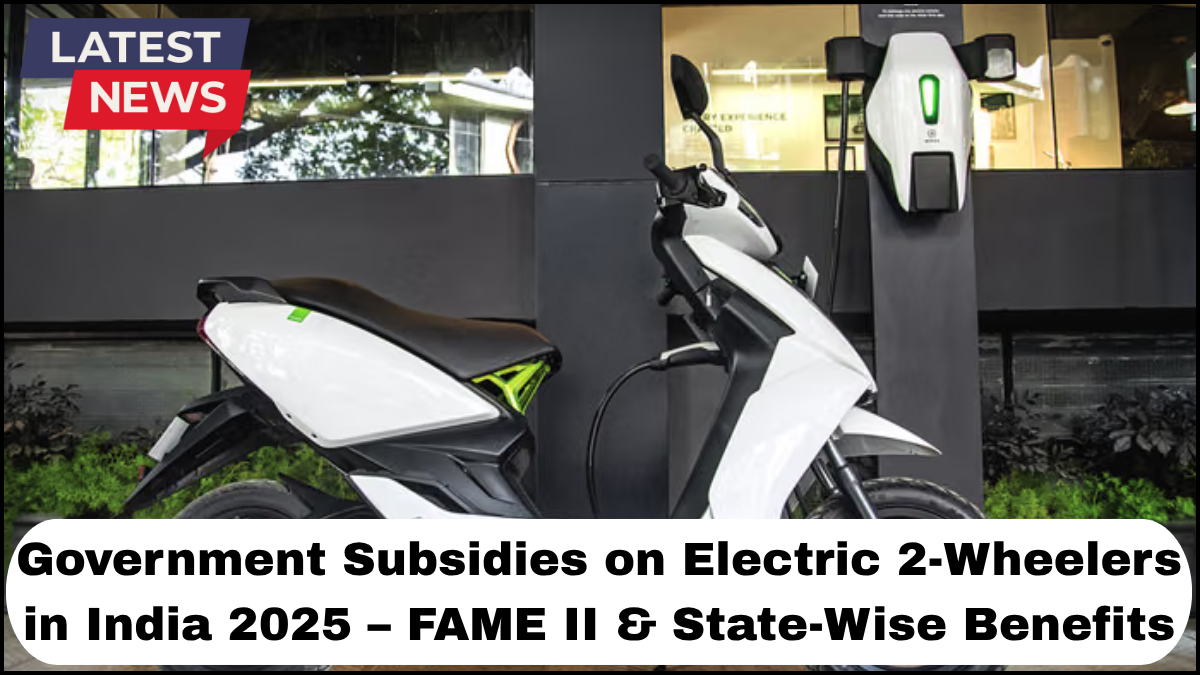In 2025, the Indian government’s push to electrify mobility has accelerated, and government subsidy on 2W EVs stands out as a powerful tool driving consumer adoption. From the central FAME II scheme to additional state-level support, the incentives landscape offers both depth and variety. This article dives deep into what’s available nationwide, break down state-wise benefits, and explain how buyers can maximize savings.

What Is FAME II & How It Supports 2‑Wheeler EVs?
FAME II (Faster Adoption and Manufacturing of Electric Vehicles Phase II) is the central government’s flagship program for promoting electric mobility. Although designed for four-wheelers, buses, and commercial vehicles, it also covers two-wheeled EVs under specific usage categories:
-
Key Features:
-
Direct purchase incentive (DPI) per vehicle based on battery capacity and performance.
-
Funding support for charging infrastructure, helping reduce total cost of ownership.
-
-
Eligibility & Application:
-
Only EV models meeting performance benchmarks (range, battery specs) qualify.
-
Consumers purchase vehicles from approved dealers. Subsidy is passed through to the dealer, effectively reducing the showroom price.
-
-
Impact in 2025:
-
Prices of eligible electric scooters and bikes are approximately ₹8,000–₹15,000 lower due to FAME II subsidy.
-
Subsidy is especially meaningful for vehicles with higher battery capacity (e.g. ≥2 kWh).
-
State‑Wise Incentives: A Comparative Overview
On top of central subsidies, many Indian states offer additional state incentives. Let’s explore how these vary across key states:
Delhi & National Capital Region (NCR)
-
Offers a one-time purchase incentive of up to ₹5,000 for electric scooters.
-
Some municipal corporations waive road tax and registration fees, leading to further reductions.
Maharashtra (Mumbai, Pune)
-
EV purchase rebate of ₹10,000 for two‑wheelers under ₹1.5 lakh ex‑showroom.
-
Registration fee exemptions and priority EV parking zones in certain urban centers.
Karnataka (Bangalore)
-
Up to ₹8,000 subsidy aside from FAME II.
-
Waived road tax and invited partnerships with e‑rental operators by offering fleet incentives.
Tamil Nadu (Chennai)
-
Offers ₹5,000 or 10% of the ex‑showroom price, whichever is lower.
-
Reduced electricity tariff for home charging (evening/free night charging slots).
Telangana (Hyderabad)
-
₹7,000 incentive and full registration fee waiver on purchase.
-
Additional ferry‑back plans include free public charging for first year.
Kerala (Thiruvananthapuram)
-
Competitive ₹5,000 extra subsidy.
-
Free installation assistance for home charging; special discounts for women and students.
Gujarat (Ahmedabad)
-
Once‑in‑a‑lifetime grant of ₹7,500 plus exemption from surcharge.
-
EV charging infrastructure support grants to apartment owners making charging easier.
Each state’s scheme is regularly updated—many states introduced new tiers in 2024‑25 and continue plans into the current year. Buyers should check their state transport or energy development boards for current eligibility windows.
How Buyers Can Maximize Their Benefits
1. Choose an Approved FAME II Model
By selecting a 2‑wheeler that meets central mandates (range, Li‑ion battery, motor power), buyers ensure they qualify for both types of incentive.
2. Stack Central & State Subsidies
Stacking is allowed: someone in Delhi can receive ₹5,000 from the state plus ₹8,000–₹15,000 via FAME II, effectively reducing the upfront cost by up to 20%.
3. Timing Your Purchase
Many states have annual or quarterly caps on incentive disbursements. Shopping early in the fiscal year increases the chance of full benefits.
4. Home Charging Support
Some states reimburse or install home chargers. Claiming grid-tied installation support can further lower user effort and cost.
5. Fleet & Institutional Options
Businesses or delivery fleets can apply for bulk subsidies under special fleet categories—typically with higher caps.
Impact of Government Subsidy on 2W EVs
-
More Affordable Vehicles: Effective subsidies reduce sticker price significantly, bringing many scooters into the ₹60,000–₹90,000 bracket, comparable to cheaper petrol options.
-
Faster Payback: With lower fuel and maintenance costs, the break-even on premium electric models shortens to under two years.
-
Higher Adoption: Since 2022, sales of electric two‑wheelers have climbed steeply. In 2024, India sold over 5 million EV two‑wheelers, supported largely by these incentives.
Challenges and Considerations
-
Budget Limitations: Some states exhaust subsidy outlays early in the financial year, which leaves late shoppers without full benefits.
-
Model Availability: Only a subset of EV models are FAME‑II certified; check certification before purchase.
-
Awareness Gap: Buyers often miss incentives by not applying at time of purchase or ignoring registration combo incentives.
Frequently Asked Questions (FAQ)
Q: Can I claim both central FAME II subsidy and state subsidy together?
A: Yes. The government subsidy on 2W EVs from FAME II and the state incentives are cumulative, if both criteria are met.
Q: Are these subsidies available across India?
A: FAME II is nationwide. However, additional state support varies—states like Delhi, Maharashtra, Karnataka, Tamil Nadu, and others offer different incentive schemes.
Q: How is the FAME II subsidy applied when I buy the vehicle?
A: It’s passed to approved dealers, reducing the ex‑showroom price at the point of sale—you don’t need to claim it separately.
Q: Is the subsidy dependent on battery size or runtime?
A: Yes. FAME II subsidy scales with battery capacity and performance benchmarks. State incentives may have fixed slabs or price caps.
Q: Do I need to install a home charger to qualify?
A: Not for purchase subsidy. However, some states offer additional help or reimbursement specifically for charger installation.
click here to learn more